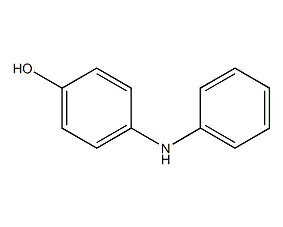4-Hydroxydiphenylamine 4-Hydroxydiphenylamine


Structural formula
| Business number | 03EX |
|---|---|
| Molecular formula | C12H11NO |
| Molecular weight | 185.22 |
| label |
p-hydroxydiphenylamine, 4-(phenylamino)phenol, 4-Anilinophenol, 4-Anilino-1-Hydroxybenzene, 4-(N-Phenylamino)Phenol, 4-(Phenylamino)-phenol, 4-Hydroxydiphenylamine, P-Hydroxydiphenylamine, P-Anilinophenol, 4-(Phenylamino)-pheno, Rubber additives |
Numbering system
CAS number:122-37-2
MDL number:MFCD00020142
EINECS number:204-538-9
RTECS number:SJ6950000
BRN number:511942
PubChem ID:None
Physical property data
1. Character: The ordinary product is reddish brown melted body, the refined product is orange
2. Melting point (℃):75~80
3. Solubility: Soluble in ethanol, ether, acetone, chloroform and benzene, slightly soluble in water, dilute alkali and inorganic acid.
Toxicological data
1, acute toxicity: rat oral LD50: 3300mg/kg
Mouse oral LD50: 2120mg/kg
Mice were injected intravenously with LD50: 60mg/kg
Unknown mammalian oral administration LD50: 3300mg/kg
Ecological data
None yet
Molecular structure data
1. Molar refractive index:57.50
2. Molar Volume(m3/mol):153.9
3. Isotonic specific volume(90.2K):415.6
4. Surface tension(dyne/cm):53.1
5. Dielectric constant:
6. Dipole moment(10-24cm3) :
153.9
3. Isotonic specific volume(90.2K):415.6
4. Surface tension(dyne/cm):53.1
5. Dielectric constant:
6. Dipole moment(10-24cm3) :
7. Polarizability:22.79
Compute chemical data
1. Reference value for hydrophobic parameter calculation (XlogP): None
2. Number of hydrogen bond donors: 2
3. Number of hydrogen bond acceptors: 2
4. Number of rotatable chemical bonds: 2
5. Number of tautomers: 4
6. Topological molecule polar surface area 32.3
7. Number of heavy atoms: 14
8. Surface charge: 0
9. Complexity: 158
10. Number of isotope atoms: 0
11. Determine the number of atomic stereocenters: 0
12. Uncertain number of atomic stereocenters: 0
13. Determine the number of chemical bond stereocenters: 0
14. Number of uncertain chemical bond stereocenters: 0
15. Number of covalent bond units: 1
Properties and stability
None yet
Storage method
1. Storage
Tightly sealed and protected from light.
Synthesis method
2. Introduction to production methods Produced by the reaction of aniline and hydroquinone; or obtained by the reaction of bromobenzene and p-aminophenol.
Purpose
3. Purpose
Intermediates for pharmaceuticals, dyes, pesticides, and rubber additives.
alt: auto; mso-margin-bottom-alt: auto” align=left>7. Polarizability:22.79
Compute chemical data
1. Reference value for hydrophobic parameter calculation (XlogP): None
2. Number of hydrogen bond donors: 2
3. Number of hydrogen bond acceptors: 2
4. Number of rotatable chemical bonds: 2
5. Number of tautomers: 4
6. Topological molecule polar surface area 32.3
7. Number of heavy atoms: 14
8. Surface charge: 0
9. Complexity: 158
10. Number of isotope atoms: 0
11. Determine the number of atomic stereocenters: 0
12. Uncertain number of atomic stereocenters: 0
13. Determine the number of chemical bond stereocenters: 0
14. Number of uncertain chemical bond stereocenters: 0
15. Number of covalent bond units: 1
Properties and stability
None yet
Storage method
1. Storage
Tightly sealed and protected from light.
Synthesis method
2. Introduction to production methods Produced by the reaction of aniline and hydroquinone; or obtained by the reaction of bromobenzene and p-aminophenol.
Purpose
3. Purpose
Intermediates for pharmaceuticals, dyes, pesticides, and rubber additives.
